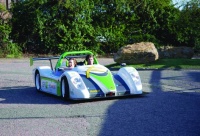The Racing Green Endurance (RGE) team, from Imperial College London, and their Radical SRZERO supercar broke the previous record held by the Tesla electric car, which did one lap around the M25 on one battery charge.
Alexander Schey, RGE project manager, and Toby Schultz, RGE energy and vehicle systems engineer, took turns driving the vehicle, which made it around the M25 twice, a total distance of 230 miles. Plus it still had enough charge to travel an extra 20 miles to West London and back.
The M25 attempt forms part of a long-term strategy by the RGE team to test the performance of SRZERO before it embarks on a trip across North and South America in July. The team plans to be the first in the world to drive an electric vehicle the entire length of the Pan American Highway, which - at 16,155 miles - stands as the longest road on Earth.
The electric supercar can accelerate from zero to about 62mph in seven seconds and it has been designed to reach a top speed of approximately 124mph.
Schey said he had put the car through exhilarating test trials – dodging and weaving at speeds reaching 85mph. However for the M25 demonstration, Schey and Schultz drove the vehicle at an average speed of 60mph.
According to Imperial College, the car has an average running cost of one penny per mile and a range of approximately 248 miles before the battery needs recharging.
Schey said one of the key things that distinguishes the SRZERO from other electric cars being rolled out is its reliance on axial-flux motor technology.
As he explained, axial flux motors are different from conventional electric motors because the path of its magnetic flux flows parallel to the axle of the motor. In a conventional motor this flux flows radiallly though a gap between the rotor and stator.
The rotor of an axial-flux motor is flatter and wider in diameter than what Schey described as the almost ‘sausage-shaped’ rotors in conventional electric motors.
A flatter rotor, he said, can be made thinner and lighter, and therefore the motors can be used in applications where quick changes in speed are necessary.
The radical new design, Schey said, also allows them to make efficiency gains by removing the need for a gearbox.

Other features include a battery-management software designed to control each battery cell and ensure none of them are putting out too much current or overheating, he said.
Schey added, ‘We also have a customised control system designed to operate two motors instead of one. Normally you have an engine or motor going through a differential. We have two motors, one on each rear wheel, so the control system has to control each motor independently. In a normal car it is a mechanical system that changes the wheel speed.’
The Racing Green Endurance project runs alongside the wider Imperial Racing Green initiative (IRG), which is training students to become the engineers who will develop the next generation of zero-emission vehicles in the future. The IRG project is an initiative of the Energy Futures Lab, which is the College’s hub for interdisciplinary energy research.
Following the M25 demonstration, Schey said he does not expect people to view the SRZERO as a practical electric car, but instead as a demonstration of the possibilities for electric-vehicle technology.
‘One of the core features of the project is to show that an electric vehicle does have the range and capacity to be a lot more like a normal driving vehicle than people expect at the moment,’ he said.










Water Sector Talent Exodus Could Cripple The Sector
Maybe if things are essential for the running of a country and we want to pay a fair price we should be running these utilities on a not for profit...